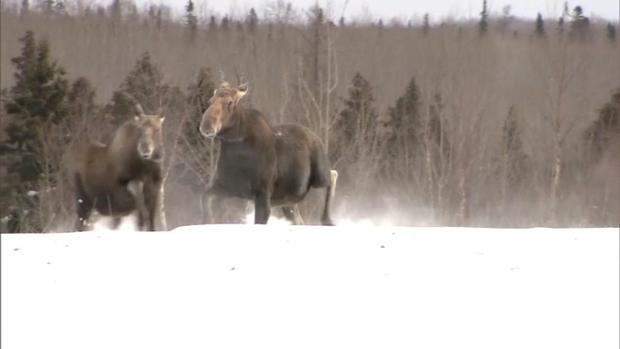How is Minnesota's unusually warm winter affecting the moose population?
ELY, Minn. — Every year, biologists take flight to count moose in Minnesota.
They're in the process of doing it right now in the Superior National Forest near Ely.
WCCO wondered how the state's largest wild animal is faring in such an usual winter. As Erin Hassanzadeh uncovered in this Next Weather Investigation, it's giving them a run for their money — for a population that's already a fraction of what it once was.
On the fringes of Minnesota's North Woods, Department of Natural Resources helicopters have a bird's eye view where you can see moose clipping through the forest.
"You get a whole different perspective on the landscape," said Mike Schrage, a Fond du Lac wildlife biologist.
The state keeps tabs on the population and sets hunting quotas for tribes by doing its annual survey. Crews fly in helicopters estimating moose populations.
READ MORE: Moose spotted in southern Minnesota, hundreds of miles from natural habitat
Collar trackers reveal how moose territory is evolving, something biologists are watching closely as the population dropped nearly 60% since 2009, from 7,840 in 2009 to 3,290 in 2023. Full population numbers from 2005-2023 can be found by clicking here.
WCCO asked if experts know why.
"A lot of theories and some data," said Schrage.
These days, most Minnesota moose call the Arrowhead region home. But it wasn't always that way.
Four thousand moose used to live in northwestern Minnesota in the '80s. Now, it's fewer than 100.
"That rate of decline for a population that large is really unprecedented," said DNR Wildlife Health Program Director Michelle Carstensen.
This year, weather is getting in the way of the annual survey.
"It's been hard. The warmer conditions, the low ceilings, foggy, misty has made it challenging to find flyable days this year," said Schrage, who is part of the crew doing the assessment.
Our lack of snow isn't helping either.
"It makes the moose pop out better when there's a consistent white background," said Schrage.
And it's not just a setback for researchers. It's a huge problem for moose, too. They can withstand minus 70 degree temps.
"If moose are getting heat stress, they're probably not eating like they should," said Schrage "Just like you and I, we don't feel like going out for a big meal on a hot day."
What's considered a hot day for a moose, you ask?
"Right around 20 degrees Fahrenheit," said Schrage.
WCCO's NEXT Weather team says Ely has had 65 days above that from Dec. 1 to Feb. 22.
Less snow also means better tick survival rates. They can swarm moose by the tens of thousands. The blood loss, with other factors, can be deadly or at least make it harder to produce viable calves. Pair that with brain worm concerns spread from a thriving whitetail deer population and you start to get the picture.
READ MORE: WCCO tests the long-distance capabilities of electric vehicles
"It all adds up," said Schrage.
"So climate has these indirect effects as well as some direct effects that we're just beginning to understand," said Carstensen.
To do that, researchers put temperature sensors in moose. They ingest them and the sensors live in their stomach and provide five years of data
"What we observed was temperatures that were above normal for sustained amount of times and we believe that might be impacting their survival over the course of the next year," said Carstensen.
Global warming could also be pushing the moose north in search of cooler temperatures.
There's disease, predators and loss of habitat, but there are also efforts to make Minnesota hospitable to moose again.
"We're trying to make sure we understand what quality habitat is for moose. So we hope to grow moose in Minnesota," said Carstensen.
There's a proposal for a $400,000 grant to restore Moose habitat in northeastern Minnesota.
"Moose do well in some kinds of forests but that's not the case for other kinds of animals and so you try to balance the two out there," said Schrage.
WCCO found a stretch of the Superior National Forest that was scorched by the Greenwood Fire in 2021. It doesn't look very picturesque to the news crew on the ground, but to a moose, it's an ideal setting for grazing. They prefer new growth and the vegetation that grows right after wildfires, logging or severe weather blowdowns.
"Minnesotans identify with moose," said Carstensen.
And despite the threat we all face in this warming climate, the work will continue to hold on to the natural wonders we're lucky to have and to build a new future where our largest wild animal thrives.
"It's part of our identity in northern Minnesota," said Schrage. "It's part of who we are up here."





